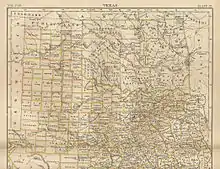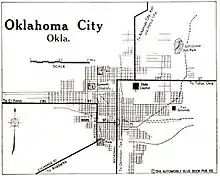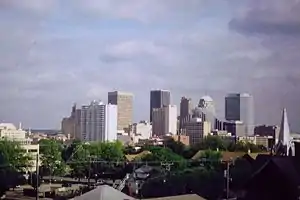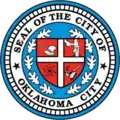History of Oklahoma City
The history of Oklahoma City refers to the history of city of Oklahoma City, and the land on which it developed. Oklahoma City's history begins with the settlement of "unassigned lands" in the region in the 1880s, and continues with the city's development through statehood, World War I and the Oklahoma City bombing.

Early history

Oklahoma City was first settled on April 22, 1889, when the area known as the "unassigned lands" (that is, land in Indian territory that had not been assigned to any tribes) was opened for settlement in an event known as "The Land Run".[1] Some 10,000 homesteaders settled the area now known as Oklahoma City; the population doubled between 1890 and 1900.[1]
Oklahoma City became the capital of Oklahoma on June 10, 1910, supplanting Guthrie, the territorial capital, as the population center and commercial hub of the new state. Early city leaders John Shartel, Anton Classen, James W. Maney and Henry Overholser helped grow the city,[1] which developed an efficient trolley system, a major regional commercial center, a railway hub and had attracted several large meat packing plants along with other industry. The city, now with a population of 64,000, put in a petition to become the new state capital. A popular vote was held, with Governor Charles N. Haskell as one of the strongest advocates for Oklahoma City's candidacy, which Oklahoma City won. The vote was not popular among Guthrie civic leaders, though, and an unknown Oklahoma City booster, most likely from the OKC Chamber of Commerce, allegedly spirited the state seal away from the state capital at Guthrie in the middle of the night to ensure the transfer. The Oklahoma State Capitol was established at N.E. 23rd Street and Lincoln Boulevard.[2] The capitol lacked a dome after its initial construction; it could not be added by the time the building was completed in 1919 due to lack of funds. A dome was finally added to the building in 2002.
Pre World War II

The new city continued to grow at a steady rate until December 4, 1928, when oil was discovered in the city. Oil wells popped up everywhere, even on the south lawn on the capitol building, and the sudden influx of oil money within the city and throughout the state greatly accelerated the city's growth. While those who had made money during this early oil boom largely escaped the Depression, the majority of Americans and Oklahomans were not so lucky. By 1935, rural migrants and unemployed workers had built a massive shanty town (or "Hooverville" after president Herbert Hoover) on the south bank of the North Canadian River.[3] The river often flooded, bringing disease and misery to the people living there. As part of the "New Deal", the Works Progress Administration and Civilian Conservation Corps greatly reduced the level of the river to prevent flooding (a move which would later become a problem for city leaders stuck with a nearly empty river) and built one of the first experiments with public housing in the country.
A municipal-owned Elm Grove camp built in 1932 and which offered better amenities to residents who paid $1 a day or donated eight hours or labor.[3] The camp was eliminated in 1933 because of a fear that it would attract more homeless residents to the city.[3] A May Avenue Camp continued to exist in 1939.[3] In 1933, the city planning commission recommended a policy restricting African Americans' ability to stay in white residential areas within the city (see sundown town).[4]
Postwar developments
The Second World War and the growing war industries brought recovery to the nation and Oklahoma City, and the post war period saw Oklahoma City become a major hub in the national Interstate Highway System. Additionally, Tinker Air Force Base in Midwest City became the largest air depot in the country in the post war period, a fact which made Oklahoma City the likely target for a possible Soviet nuclear strike. As the civil rights era dawned, downtown Oklahoma City became the site of a revolution in civil rights tactics. History teacher Clara Luper and some of her students from nearby Douglass High School led the first "sit in" in American history to desegregate the lunch counter at a downtown department store in 1958.[5] When they succeeded, the tactic was adopted throughout the country, notably by the young activists of SNCC.
From February 3 to July 29, 1964, Oklahoma City was subjected to eight sonic booms per day in a controversial experiment known as the Oklahoma City sonic boom tests. The intent was to quantify the sociological and economic costs of a supersonic transport aircraft. The experiment resulted in 15,400 damage claims. The persistence of the experiment and the 94% rejection rate of damage claims led to turmoil at all levels of government and embroiled Senator Mike Monroney's office in a battle with the Federal Aviation Administration. The embarrassment over the Oklahoma City experiments partially contributed to the demise of the Boeing 2707 SST project seven years later.
Decline and stagnation

As the 1960s continued, however, Oklahoma City began to decline. By 1970, "white flight" and suburbanization had drained the life from the central business district and the surrounding areas. The oil beneath the city had begun to dry up, and property values declined. The city leaders then engaged in a disastrous program of "urban renewal" which succeeded primarily in demolishing much of the aging theater district. Despite popular conjecture, the impressive Biltmore Hotel was not originally targeted to be taken down by the Oklahoma City Urban Renewal Authority. Plans drawn up for downtown's redevelopment by I.M. Pei always assumed the building would remain open for business. After a $3 million renovation in the mid-1960s, the hotel was renamed the Sheraton-Oklahoma Hotel. But, the operation could not turn a profit, and in 1973, hotel owners agreed with the authority the building had outlived its useful life and needed to be demolished.[6] The city had planned to build a massive shopping mall called "The Galleria" downtown, but money for renewal ran out before they could construct more than the parking garage for it. This left downtown Oklahoma City in even worse shape than it had been in, with vacant lots where Victorian brownstones once stood. The 1970s and 1980s were periods of stagnation for Oklahoma City proper (and was the case for almost all major cities in the United States) and periods of affluence and explosive development for the suburbs. With the exception of The Myriad Gardens, little was done to improve the inner city or the central business district during this time, even as the oil boom of the late 1970s brought a flood of money into the area.
1990s

By 1992, the city was in such dire need of improvement that it was losing jobs, population, and even air carriers to more attractive cities. With this in mind, Mayor Ron Norick pushed through a massive plan for capital improvements throughout downtown called the Metropolitan Area Projects Plan, or MAPS. MAPS called for a five-year, one-cent sales tax to fund a new ballpark, a canal through Bricktown, a new central library, a large indoor arena, renovations to the fairgrounds and the civic center, and a series of low water dams on the North Canadian River to make it attractive and accessible to small boats. Though still stinging from the failure of "urban renewal", the people of Oklahoma City passed the measure, eventually raising over 1 billion dollars for improvements to the city and bringing life back to the central city.
Oklahoma City bombing

In the midst of this atmosphere of optimism and change, Timothy McVeigh drove a rented truck full of explosives to the Alfred P. Murrah Federal Building in downtown Oklahoma City on April 19, 1995.[7][8] The explosion killed 168 people (including 19 children) and injured more than 680, as well as damaging and destroying many surrounding buildings.[9] Until the attacks of September 11, it was the largest terrorist attack on American soil, and it remains the single largest domestic terrorist attack in American history.[10][11]
The site is now home to the Oklahoma City National Memorial. The memorial was designed by Oklahoma City architects Hans and Torrey Butzer, and Sven Berg and was dedicated by President Clinton on April 19, 2000, exactly five years after the bombing.[12] Oklahoma City has since rebuilt, and except for the memorial, there is little evidence of the bombing.
The Federal Bureau of Investigation led an investigation, known as OKBOMB,[13] the largest criminal case in America's history (FBI agents conducted 28,000 interviews, amassed 3.5 short tons (3.2 t) of evidence, and collected nearly one billion pieces of information).[14] Special Agent in Charge Weldon L. Kennedy.[15] commanded the largest crime task force since the investigation into the assassination of John F. Kennedy. The task force included 300 FBI agents, 200 officers from the Oklahoma City Police Department, 125 members of the Oklahoma National Guard, and 55 officers from the Oklahoma Department of Public Safety.[16]
21st century
As Oklahoma City moves through the 21st century, new changes continue to bring population, jobs, entertainment, and improvement. In 2004, a new Dell call center brought over 250 jobs, and plans to employ over 19,000 more jobs in the future. 2005 brought Oklahoma its first major league basketball franchise, the New Orleans/Oklahoma City Hornets, followed by becoming the permanent home of the renamed Seattle NBA franchise, now the Oklahoma City Thunder, in 2008. Many other corporations are making Oklahoma City their home and the population is once again increasing at a very high rate. Also, a new addition to the downtown skyline, Devon Energy Center, was completed in 2012, with 52 stories and a height of 850 feet.[17]
Notes
- Wilson, Linda D. "", [ Encyclopedia of Oklahoma History and Culture]. (accessed January 26, 2010).
- Savage, Cynthia."", [Encyclopedia of Oklahoma History and Culture]. (accessed January 26, 2010).
- Weisiger, Marsha L., ", [ Encyclopedia of Oklahoma History and Culture] (accessed May 26, 2010).
- "Place Limit on Living Quarters". Key West Citizen. Key West, Florida. Associated Press. August 25, 1933. p. 4 – via Chronicling America.
Hundreds of negroes may be affected by city planning commission recommendations that negroes be allowed to live on servant's quarters in white residential areas only when they are employed on the premises.
- Decker, Stefanie Lee. "", [ Encyclopedia of Oklahoma History and Culture]. (accessed January 26, 2010).
- "Biltmore Hotel". OKHistory.org. Retrieved January 29, 2014.
- Linenthal, Edward Tabor. "Oklahoma City Bombing". Encyclopedia of Oklahoma History and Culture. Retrieved January 26, 2010.
- Thomas, Jo (April 30, 1996). "For First Time, Woman Says McVeigh Told of Bomb Plan". The New York Times. Retrieved June 5, 2009.
- Shariat, Sheryll; Sue Mallonee; Shelli Stephens-Stidham (December 1998). "Oklahoma City Bombing Injuries" (PDF). Injury Prevention Service, Oklahoma State Department of Health. Shariat & al. count only 167 killed "as a direct result of the bombing or during escape". Obviously they did not include Rebecca Needham Anderson, who – having seen the bombing on TV in Midwest City, Oklahoma – came to the rescue and was killed by a piece of falling debris. http://www.people.com/people/archive/article/0,,20105677,00.html
- Thomas, Jo (May 23, 1997). "McVeigh Defense Team Suggests Real Bomber Was Killed in Blast". The New York Times. Retrieved June 5, 2009.
- Mlakar Sr., Paul F.; W. Gene Corley; Mete A. Sozen; Charles H. Thornton. "Blast Loading and Response of Murrah Building" (PDF). Forensic Engineering. Archived from the original (PDF) on 2009-11-30. Retrieved June 26, 2009.
- , National Park Service. (accessed June 5, 2009)
- "Statement of Special Agent in Charge Danny Defenbaugh Regarding OKBOMB Documents" (Press release). FBI. May 11, 2001. Archived from the original on February 27, 2011. Retrieved June 5, 2009.
- "Lessons learned, and not learned, 11 years later". NBC News. Associated Press. April 16, 2006. Retrieved March 25, 2009.
- "Investigator List". CNN Interactive. Archived from the original on March 9, 2008. Retrieved June 5, 2009.
- Hamm, Mark S. Apocalypse in Oklahoma. p. 76.
- "Devon Energy Center - The Skyscraper Center". www.skyscrapercenter.com. Retrieved 2020-04-08.
References
- Linenthal, Edward Tabor. "Oklahoma City Bombing", Encyclopedia of Oklahoma History and Culture. (accessed January 26, 2010).
- Savage, Cynthia. "Oklahoma State Capitol", Encyclopedia of Oklahoma History and Culture. (accessed January 26, 2010).
- Widener, Jeffrey M., "The Latino Impress in Oklahoma City", Chronicles of Oklahoma, (Spring 2011), 89#1 pp 22–51.
- Wilson, Linda D. "Oklahoma City", Encyclopedia of Oklahoma History and Culture. (accessed January 26, 2010).


